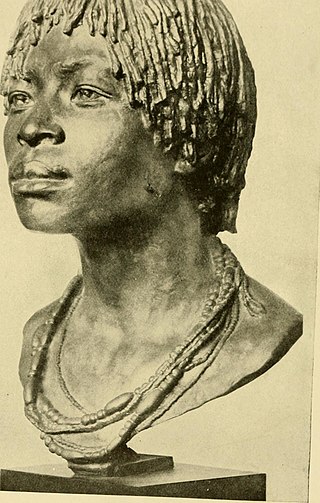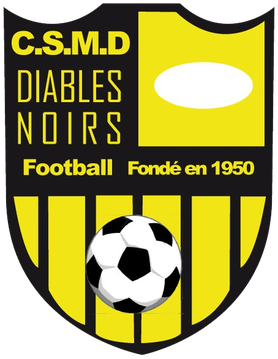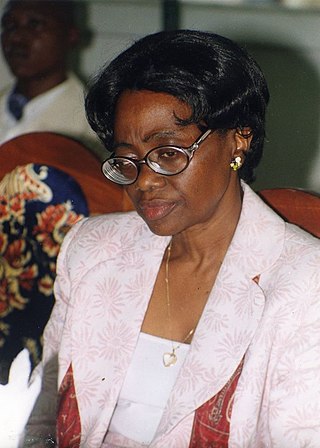
The history of the Republic of the Congo has been marked by diverse civilisations: Indigenous, French and post-independence.

Brazzaville is the capital and largest city of the Republic of the Congo. From an administrative perspective, it is a department and a commune. Constituting the financial and administrative centre of the country, it is located on the north side of the Congo River, opposite Kinshasa, the capital city of the Democratic Republic of the Congo.

Bangui is the capital and largest city of the Central African Republic. It was established as a French outpost in 1889 and named after its location on the northern bank of the Ubangi River ; the Ubangi itself was named from the Bobangi word for the "rapids" located beside the settlement, which marked the end of navigable water north from Brazzaville. The majority of the population of the Central African Republic lives in the western parts of the country, in Bangui and the surrounding area.

Soukous is a genre of dance music originating from the Democratic Republic of the Congo and the Republic of the Congo. It derived from Congolese rumba in the 1960s, with faster dance rhythms and bright, intricate guitar improvisation, and gained popularity in the 1980s in France. Although often used by journalists as a synonym for Congolese rumba, both the music and dance associated with soukous differ from more traditional rumba, especially in its higher tempo and longer dance sequences.

The Kongo people are a Bantu ethnic group primarily defined as the speakers of Kikongo. Subgroups include the Beembe, Bwende, Vili, Sundi, Yombe, Dondo, Lari, and others.

Pointe-Noire is the second largest city in the Republic of the Congo, following the capital of Brazzaville, and an autonomous department and a commune since the 2002 Constitution. Before this date it was the capital of the Kouilou region. It is situated on a headland between Pointe-Noire Bay and the Atlantic Ocean. Pointe-Noire is the main commercial centre of the country and has a population of more than 1 million inhabitants since 2018.
André Grenard Matswa was a Congolese Lari anti-colonial activist born near Manzakala-Kinkala in then Middle Congo, a rare influential figure in Congolese politics before independence in 1960. He inspired a messianic cult, Matswanism or Matsouanism, that emerged in the French Equatorial African capital, Brazzaville.

The wildlife of Sierra Leone is very diverse due to the variety of different habitats within the country. Sierra Leone is home to approximately 2090 known higher plant species, 147 known species of mammals, 172 known breeding bird species, 67 known reptile species, 35 known amphibian species and 99 known species of fish.

Club Sportif Multidisciplinaire Diables Noirs or simply CSMD Diables Noirs is a Congolese football club based in Brazzaville.
The Roman Catholic Archdiocese of Pointe-Noire is an archdiocese located in the city of Pointe-Noire in the Republic of the Congo. This province has suffragan dioceses Dolisie and Nkayi.

The Republic of the Congo, also known as Congo-Brazzaville, the Congo Republic or simply either Congo or the Congo, is a country located on the western coast of Central Africa to the west of the Congo River. It is bordered to the west by Gabon, to its northwest by Cameroon and its northeast by the Central African Republic, to the southeast by the Democratic Republic of the Congo, to its south by the Angolan exclave of Cabinda and to its southwest by the Atlantic Ocean.

Gregoire was, up until his death, Africa's oldest known chimpanzee. For the last eleven years of his life, he was a resident of the Tchimpounga Sanctuary in the Republic of the Congo. He was observed to have a pair bond relationship with the chimpanzee Clara. Previously he had been confined by himself for more than 40 years in a cage at the Brazzaville Zoo before being rescued by staff of the Jane Goodall Institute and airlifted to the Sanctuary during a time of war.
Jean Félix-Tchicaya was a Congolese politician in the French colony of Middle Congo. He was born in Libreville on November 9, 1903, and was a member of the royal family of the Kingdom of Loango.
The Pan African Sanctuary Alliance (PASA) is an association of wildlife centers in Africa, founded in 2000 in Uganda. The activities of PASA includes rescuing and caring for orphaned apes and monkeys, promoting the conservation of wild primates, educating the public, empowering communities, and working to stop the illegal trade in wildlife.

Agathe Félicie Lélo Pembellot was the first female judge of Republic of the Congo Brazzaville. She has held several positions in the Senior Congolese Judiciary.

The Vili people are a Central African ethnic group, established in southwestern Gabon, the Republic of Congo, Angola and the Democratic Republic of Congo. It's a subgroup of Bantu and Kongo peoples.
Loango is a town of the Republic of the Congo.

Loango Slavery Harbour is a Republic of the Congo cultural site included in World Heritage Tentative Lists in 2008–09.
François Luc Macosso was a Congolese politician.
La Semaine Africaine is a French-language weekly newspaper published in Brazzaville, Republic of the Congo, and serving Central Africa. La Semaine is owned by the Roman Catholic Episcopal Conference of the Congo, but maintains editorial independence. Founded in 1952 as La Semaine de l'AEF, it received its present title in 1960, when the Republic of the Congo gained independence from France. Between 1963 and 1990, it was the only media outlet in the Republic of the Congo not controlled by the state. In 1970, its circulation was greater than 10,000. Contributing writers have included Sylvain Bemba, Emmanuel Damongo-Dadet, and Jean Clotaire Hymboud.

















